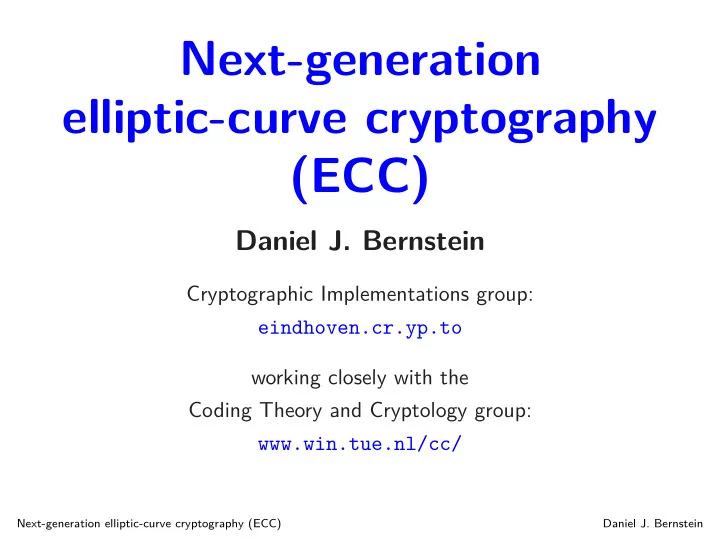

Next-generation elliptic-curve cryptography (ECC) Daniel J. Bernstein Cryptographic Implementations group: eindhoven.cr.yp.to working closely with the Coding Theory and Cryptology group: www.win.tue.nl/cc/ Next-generation elliptic-curve cryptography (ECC) Daniel J. Bernstein
Security failures in ECC standards Remote Timing Attacks are Still Practical ⋆ Billy Bob Brumley and Nicola Tuveri Aalto University School of Science, Finland {bbrumley,ntuveri}@tcs.hut.fi Abstract. For over two decades, timing attacks have been an active area of research within applied cryptography. These attacks exploit cryp- tosystem or protocol implementations that do not run in constant time. When implementing an elliptic curve cryptosystem with a goal to pro- vide side-channel resistance, the scalar multiplication routine is a critical component. In such instances, one attractive method often suggested in the literature is Montgomery’s ladder that performs a fixed sequence of curve and field operations. This paper describes a timing attack vulnera- bility in OpenSSL’s ladder implementation for curves over binary fields. We use this vulnerability to steal the private key of a TLS server where the server authenticates with ECDSA signatures. Using the timing of the exchanged messages, the messages themselves, and the signatures, we mount a lattice attack that recovers the private key. Finally, we de- Next-generation elliptic-curve cryptography (ECC) Daniel J. Bernstein
More security failures in ECC standards Next-generation elliptic-curve cryptography (ECC) Daniel J. Bernstein
The math splits into cases handled differently in software Next-generation elliptic-curve cryptography (ECC) Daniel J. Bernstein
The math splits into cases handled differently in software Next-generation elliptic-curve cryptography (ECC) Daniel J. Bernstein
. . . or does it? 2007 Bernstein–Lange, for any non-square d : The Edwards addition law � x 1 y 2 + y 1 x 2 , y 1 y 2 − x 1 x 2 � ( x 1 , y 1 ) + ( x 2 , y 2 ) = 1 + dx 1 x 2 y 1 y 2 1 − dx 1 x 2 y 1 y 2 is a complete addition law on E : x 2 + y 2 = 1 + dx 2 y 2 . Next-generation elliptic-curve cryptography (ECC) Daniel J. Bernstein
. . . or does it? 2007 Bernstein–Lange, for any non-square d : The Edwards addition law � x 1 y 2 + y 1 x 2 , y 1 y 2 − x 1 x 2 � ( x 1 , y 1 ) + ( x 2 , y 2 ) = 1 + dx 1 x 2 y 1 y 2 1 − dx 1 x 2 y 1 y 2 is a complete addition law on E : x 2 + y 2 = 1 + dx 2 y 2 . This is one part of next-generation ECC. For more: see 2016 Bernstein–Lange paper “Failures in NIST’s ECC standards”. Next-generation elliptic-curve cryptography (ECC) Daniel J. Bernstein
Building next-generation ECC 2005 Bernstein: X25519 encryption scheme using new elliptic curve Curve25519 . Next-generation elliptic-curve cryptography (ECC) Daniel J. Bernstein
Building next-generation ECC 2005 Bernstein: X25519 encryption scheme using new elliptic curve Curve25519 . 2011 Bernstein–Duif–Lange–Schwabe–Yang: EdDSA signatures (generalized by 2015 Bernstein–Josefsson–Lange–Schwabe–Yang), and in particular Ed25519 using Curve25519. Next-generation elliptic-curve cryptography (ECC) Daniel J. Bernstein
Building next-generation ECC 2005 Bernstein: X25519 encryption scheme using new elliptic curve Curve25519 . 2011 Bernstein–Duif–Lange–Schwabe–Yang: EdDSA signatures (generalized by 2015 Bernstein–Josefsson–Lange–Schwabe–Yang), and in particular Ed25519 using Curve25519. 2006, 2007, 2009, 2011, 2012, 2013, 2014, 2014, 2015, 2015, 2015: Curve25519 implementation papers from 23 authors setting speed records for conservative ECC on many different platforms. Next-generation elliptic-curve cryptography (ECC) Daniel J. Bernstein
Building next-generation ECC 2005 Bernstein: X25519 encryption scheme using new elliptic curve Curve25519 . 2011 Bernstein–Duif–Lange–Schwabe–Yang: EdDSA signatures (generalized by 2015 Bernstein–Josefsson–Lange–Schwabe–Yang), and in particular Ed25519 using Curve25519. 2006, 2007, 2009, 2011, 2012, 2013, 2014, 2014, 2015, 2015, 2015: Curve25519 implementation papers from 23 authors setting speed records for conservative ECC on many different platforms. Also: new crypto library, new verification tools, . . . Next-generation elliptic-curve cryptography (ECC) Daniel J. Bernstein
Deployment: iOS, Signal, OpenSSH, Tor, QUIC, more Next-generation elliptic-curve cryptography (ECC) Daniel J. Bernstein
The Internet standards committees start paying attention Next-generation elliptic-curve cryptography (ECC) Daniel J. Bernstein
. . . and delegate to their crypto unit, IRTF CFRG Next-generation elliptic-curve cryptography (ECC) Daniel J. Bernstein
CFRG 2014+2015: > 4000 messages, mostly on ECC Next-generation elliptic-curve cryptography (ECC) Daniel J. Bernstein
January 2016: RFC with next-gen curves + encryption Next-generation elliptic-curve cryptography (ECC) Daniel J. Bernstein
Coming soon: RFC with next-gen signature system Next-generation elliptic-curve cryptography (ECC) Daniel J. Bernstein
Coming soon: standardizing next-gen ECC for TLS Next-generation elliptic-curve cryptography (ECC) Daniel J. Bernstein
Recommend
More recommend